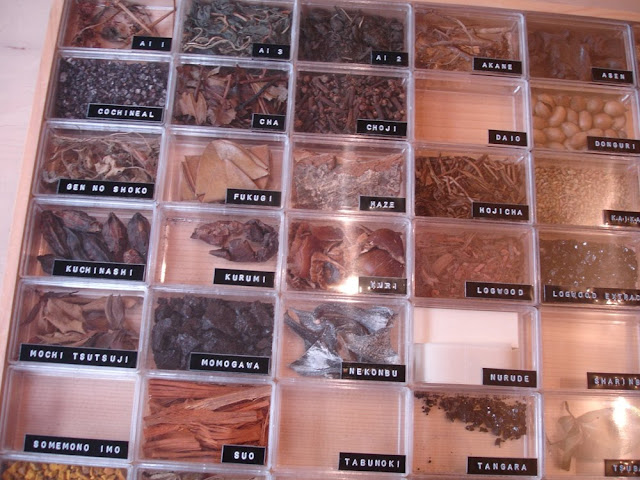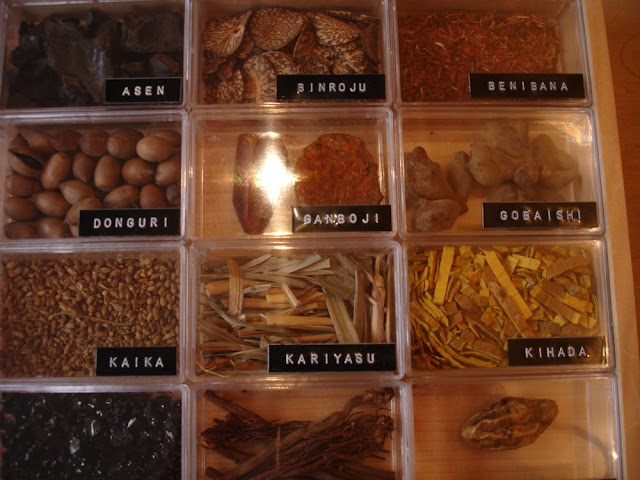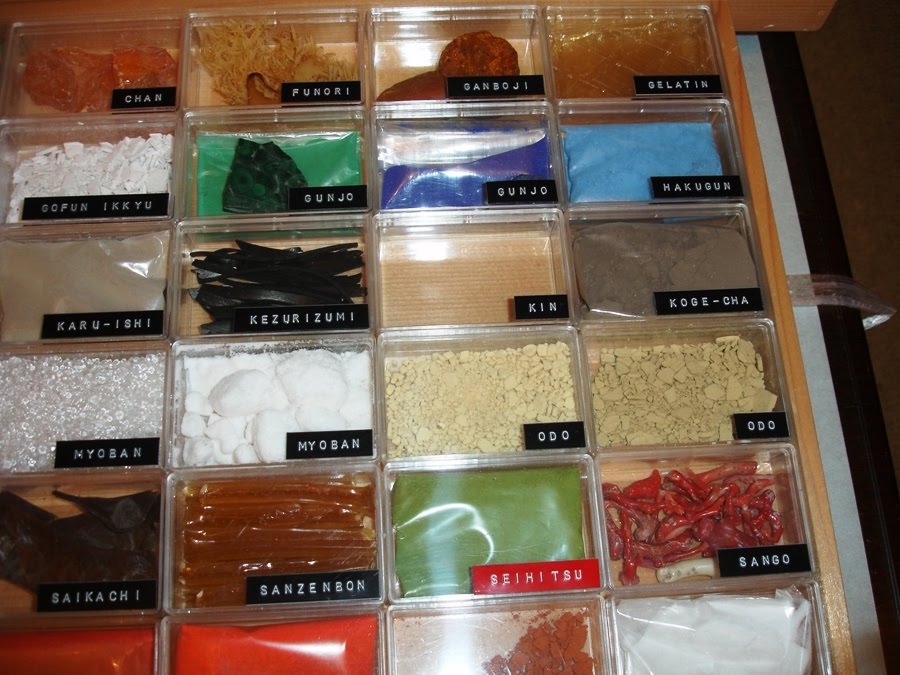 This photo is self explanatory, the poor old moths that cocoon their young in silk, only for the silkworm breeder to come along suffocate the larvae inside the cocoon and take the silk. The central silk is called a 'hankerchief' from which you can unwind the silk for spinning.
This photo is self explanatory, the poor old moths that cocoon their young in silk, only for the silkworm breeder to come along suffocate the larvae inside the cocoon and take the silk. The central silk is called a 'hankerchief' from which you can unwind the silk for spinning. The wide variety of plants, insects and bark for dyeing
The wide variety of plants, insects and bark for dyeing Some familars here, cochineal, the red beetle which you grind to make a lovely corally red, though of course all dyeing is dependent on the material dyed. The three top Al/A2/A3 are indigo plants (indoferas range)
Some familars here, cochineal, the red beetle which you grind to make a lovely corally red, though of course all dyeing is dependent on the material dyed. The three top Al/A2/A3 are indigo plants (indoferas range)
 Similar
Similar
 Mineral dyes used for paints; though that tamamushi looks like an exotic beetle, and apparently pearls are also ground down for painting with.
Mineral dyes used for paints; though that tamamushi looks like an exotic beetle, and apparently pearls are also ground down for painting with. minerals
minerals
Notes on minerals;
Haku means foil or gilt, so Kin (gold) Gin (silver);
Gofun = oyster shells. Ikkyu means best quality. Moriage gofun means gofun used for 'raised' white paint - eg petals. The use of gofun is unique to Japan and is found in both paintings and prints, In China and Korea lead white was used.
Karuishi = pumice stone
Matsu yani = pine resin
Konjo = prussian blue - ultramarine?
Hakkin = platinimum
Arabia goum = must be arabic gum (used in potpourri)
Chan = resin?
Mitsuda/mitsuba = bonewort?
Myoban = alum
A1 = indigo
odoko = copper pyrites, chalcopyrites
rokusho = verdigris?
saikuchi = metal or resin again?
Bauryoku?
Shika Nikawa = nikawa is glue
Shingyu kawa
Shinju = pearl
Tetsu fun = metal?
Tam
Links; with thanks to Printmaterial - A history of Sashiko in Japan
http://www.sashiko.org.uk/tpl/pdf/Sashiko%20Textiles.pdf
The York exhibition of Sashiko, ended 03/1/2010
http://www.yorkartgallery.org.uk/Page/ViewNewsArticle.aspx?ArticleId=24
Thelma,
ReplyDeleteWhat treasures! This looks like a fascinating collection. I envy you. It would be so interesting to see what colours they would produce and I wonder which mordant the Japanese favoured? I assume they would have used them for dyeing silk but a friend has just visited the sashiko exhibition in York and she said most of the textiles there were cotton and all dyed ,after stitch resisting, with indigo. So very interesting. Thanks for sharing. Lesley
Hi Lesley, Yes they are interesting, tried to name some of the plants, or insects even, locusts/grasshopper/cicada but gave up in the end. Alum is one of the mordants probably. There are also pine resins as well, used for glue I suppose, LS makes his own glue for that delicate match between paper and silk.
ReplyDeleteThe little iridiscent tamasushi beetle has a shrine in a temple somewhere. I will look up that Sashiko exhibition in York, though it doesnt look like travelling for anyone at the moment.
Thelma
What a fantastic collection! Do you have, in your collection some of these dyes and pigments:
ReplyDeletebeni,ukon,ai,aigami,suo,kibada,euji, kuschinashi, inorg,ki-wo,shi-wo,airo,shu,benigara,tan,zumi....not positive about spelling....:-((((
Thanks a lot
Dusan
Not sure, ukon I recognise, but it is difficult to list them all, though if you click on the photos you will see that they enlarge and you can read the writing.
ReplyDelete